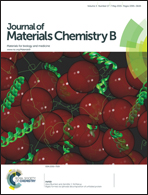Decorating graphene oxide/nanogold with dextran-based polymer brushes for the construction of ultrasensitive electrochemical enzyme biosensors†
Abstract
A novel strategy was employed to prepare a water-soluble graphene derivative by using dextran-based polymer brushes as solubilizing agents. Graphene oxide was grafted with (3-mercaptopropyl) trimethoxysilane and further decorated with Au nanoparticles. This hybrid nanomaterial was then reduced and anchored with polysaccharide-based polymer brushes by chemisorption of an end-group thiolated dextran derivative on the Au nanoparticles. The resulting hybrid nonmaterial allowed highly stable aqueous dispersions to be obtained, which were used to coat glassy carbon electrodes for the preparation of a model tyrosinase electrochemical biosensor for catechol. The enzyme electrode showed excellent electroanalytical performance with fast response in about 5 s, a linear range of 100 pM–120 nM, a very high sensitivity of 45.9 A M−1 and a very low detection limit of 40 pM for catechol.


 Please wait while we load your content...
Please wait while we load your content...